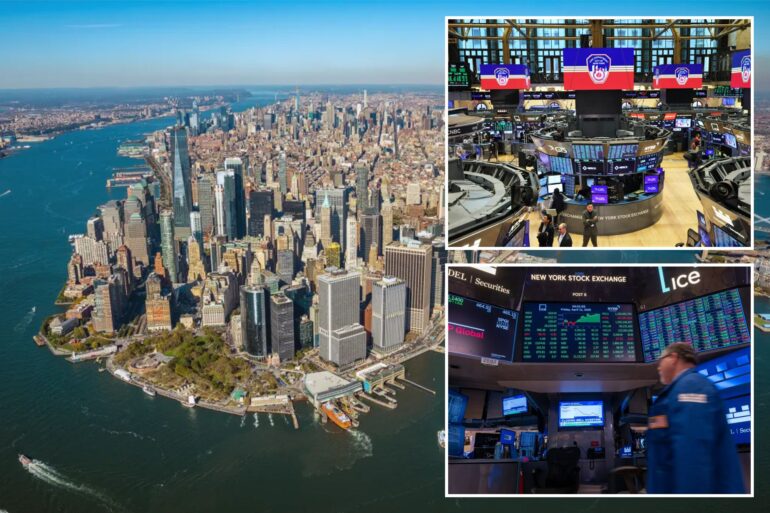🔴 Website 👉 https://u-s-news.com/
Telegram 👉 https://t.me/usnewscom_channel
After a week of tariff-driven ups-and-downs in the financial markets, New York City’s economy may soon start feeling woozy.
The longtime finance capital stands to lose more than just luster in a rapidly de-globalizing world: Billions in city tax revenue and thousands of jobs are on the line.
Greater uncertainty will make foreign and domestic companies more risk-averse, turning them away from dealmaking.
Fewer buyouts and mergers mean leaner times — and not just for investment bankers and hedge fund tycoons.
It may be hard to pity an industry whose members in the city get bonuses averaging $244,000, but New York runs on Wall Street.
Besides generating 20% of Gotham’s total income, finance funds a big chunk of the city’s essential services and safety net.
About 23% of the city’s personal income tax collections and 7% of its total tax revenue come from the securities industry, according to state Comptroller Tom DiNapoli.
That’s more than $5 billion annually out of the current year’s $112 billion budget.
History shows that the city’s fortunes are joined at the hip with Wall Street’s.
By 1977, Wall Street jobs had dwindled to 70,000, declining by some 30% during that bad old decade.
As the city clawed back from fiscal ruin, the finance industry boomed in the Gordon Gekko 1980s, more than doubling employment to 160,000.
That set the stage for the extraordinary safety improvements and prosperity of the feel-good 1990s.
Today, big banks, hedge funds and asset managers lease space in or own the city’s choicest skyscrapers and spend big bucks on corporate-card dinners, making them indispensable to real estate, restaurants and retail.
Yet New York needs Wall Street far more than Wall Street needs New York.
Securities jobs in the city peaked in 2000, when they numbered roughly 200,000, and fell after 9/11.
A quarter-century later, despite the sector’s enormous growth, the industry accounts for about 195,000 Big Apple jobs.
The reason? Competitors like Dallas and Miami are eating New York’s lunch, as firms increasingly choose to locate new operations in the Sun Belt.
Texas surpassed the Empire State’s total finance employment a decade ago, and the gap has only widened since.
Wall Street giants BlackRock and Citadel Securities have teamed up to launch the Texas Stock Exchange, set to start trading early next year.
Just last month, the Nasdaq announced that it will open a new regional headquarters in Dallas.
The danger isn’t necessarily that the leading lights of the world’s capital markets are all going to decamp from New York for good.
It’s more that they’ll keep a trophy office and smaller staff in the city as a meeting hub — but locate most of their operations and workforce elsewhere.
In these other cities, lower housing and living costs allow firms to pay employees less, even as they still take home more at the end of the week.
If the national economy slows, these savings will look even more appealing.
Meanwhile, many of New York City’s expenses are fixed — and thus depend on a growing local economy.
If your 401(k) balance has made you uneasy lately, just think: The city has to make good on pension promises to some 750,000 current and retired employees.
When a stock-market decline doesn’t allow the city’s pension funds to hit their target 7% annual growth rate, Gotham’s taxpayers are on the hook for the difference.
The city’s bloated $116 billion FY 2026 budget won’t pay for itself, especially with the Trump administration’s cuts to federal funding.
It’s time for Mayor Eric Adams to batten down the hatches and ramp up emergency budget measures until the storm clouds clear.
He can start by declaring a hiring freeze across agencies for non-uniformed positions —the opposite of his new proposal to hire 3,700 more city teachers.
Instead, he should close failing schools, merge under-enrolled ones, and decrease school-level funding in proportion to enrollment declines.
Adding to the city’s $2 billion rainy-day fund — while he still can — would further cushion the blow of a potential recession. The savings account currently amounts to only 1.7% of the annual budget, and hasn’t been growing sufficiently.
Adams should freeze spending related to Local Law 97, the de Blasio-era law that mandates big carbon cuts across city operations. Halting these efforts could save up to $2 billion a year.
Meanwhile, the Department of Housing Preservation and Development plans to spend at least $700 million annually over the next decade on new low-income housing construction: Trimming this back — and instead allowing the private sector to build more housing without public subsidies — would reduce the city’s debt load and annual interest payments.
Spending less money is rarely popular, but Adams shouldn’t wait for a budget crunch before doing the responsible thing.
Strong fiscal leadership could even help him stand out among his competitors in November’s general election.
After all, when the waters get choppy, a steady hand at the wheel keeps the ship on course.
John Ketcham is director of cities and a legal policy fellow at the Manhattan Institute.

